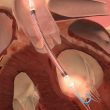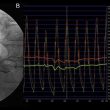According to several studies, in patients with high-risk atherosclerotic disease, such as those affected by coronary artery disease, achieving target LDL levels through high-intensity statin therapy has been shown to lead to a significant reduction in long-term cardiovascular events. Therefore, the management of dyslipidemia has become a fundamental pillar of secondary prevention. However, reaching such<a href="https://solaci.org/en/2023/10/04/anti-lipid-therapy-in-pci-patients-monotherapy-with-statins-or-combination/" title="Read more" >...</a>
BIFURCAT Registry: Long Term Diabetes Impact on Bifurcations PCI Outcomes
The impact of diabetes in patients with coronary artery disease (CAD) are well known, and after percutaneous coronary intervention (PCI), outcomes tend to be less favorable, with higher restenosis rate, repeat myocardial infarction (MI) and stent thrombosis. Despite the development of drug eluting stents, procedures and techniques, treating bifurcation lesions in diabetic patients still show<a href="https://solaci.org/en/2023/09/15/bifurcat-registry-long-term-diabetes-impact-on-bifurcations-pci-outcomes/" title="Read more" >...</a>
ESC 2023 | Anticoagulation After Primary PCI in STEMI Patients
The empirical prescription of anticoagulants after percutaneous coronary intervention (PCI), also know as post-procedural anticoagulation (PPA), is nowadays a common practice that uses various types of medications. Despite studies like HORIZONS-AMI and EUROMAX, in which 41% of patients received PPA, and the CCC-ACS registry, where 75% of subjects received PPA after primary PCI, European and<a href="https://solaci.org/en/2023/08/30/esc-2023-anticoagulation-after-primary-pci-in-stemi-patients/" title="Read more" >...</a>
SOLACI-SBHCI 2023 | Patient-centered Selection Anti-platelet Treatment for ACS-PCI Patients: Real World Evidence of Prasugrel – Dr. Roxana Mehran
Read the most outstanding articles from SOLACI-SBHCI 2023 Congress. In this case, check the presentation by Dr. Roxana Mehran, entitled “Patient-centered Selection Anti-platelet Treatment for ACS-PCI Patients: Real World Evidence of Prasugrel”.
SOLACI-SBHCI 2023 | Is very short DAPT safe in HBR patients undergoing complex PCI – Dr. Marco Valgimigli
Read the most outstanding articles from SOLACI-SBHCI 2023 Congress. In this case, check the presentation by Dr. Marco Valgimigli, entitled “Is very short DAPT safe in HBR patients undergoing complex PCI”
Long Term Outcomes after Complex PCI According to Operator Experience and Use of IVUS
The use of intravascular ultrasound (IVUS) to guide percutaneous coronary interventions (PCI) has been shown to reduce the risk of major adverse cardiovascular events (MACE) across controlled randomized studies, registries and meta-analysis. Current guidelines recommend the use of IVUS in left main disease and complex lesions. As the prevalence of complex PCI increases over time,<a href="https://solaci.org/en/2023/08/16/long-term-outcomes-after-complex-pci-according-to-operator-experience-and-use-of-ivus/" title="Read more" >...</a>
Are There Sex Differences in pLVAD-Assisted High Risk PCI?
The proportion of patients undergoing high risk PCI (HRPCI) is on the rise. It includes patients with different clinical, anatomical and procedural characteristics, such as low ejection fraction, severe vascular disease, three vessel or left main disease, severe lesion calcification and the use of atherectomy. Mechanical circulatory support devices (MCS) during HRPCI, such as the<a href="https://solaci.org/en/2023/07/26/are-there-sex-differences-in-plvad-assisted-high-risk-pci/" title="Read more" >...</a>
No Reflow after Primary PCI in STEMI: An Angiographic Analysis of the TOTAL Study
In the early days of percutaneous coronary intervention (PCI) in patients with ST elevation acute myocardial infarction (STEMI), no reflow phenomenon was known as an indicator of the worst possible outcomes in terms of left ventricular remodeling, infarct size, ejection fraction and mortality, at long term. The TOTAL study (Routine Aspiration Thrombectomy with PCI Versus<a href="https://solaci.org/en/2023/07/17/no-reflow-after-primary-pci-in-stemi-an-angiographic-analysis-of-the-total-study/" title="Read more" >...</a>
Post PCI Functional Assessment for Focal Lesion and Stent Underexpansion Detection
The use of fractional flow reserve (FFR) and non-hyperemic pressure indices (NHPRs) have become essential for intermediate lesion revascularization. A linear inverse correlation has been recently shown between the use of post PCI physiology and cardiovascular events at followup. However, its adoption has been limited so far, seeing the wide variety of algorithms used in<a href="https://solaci.org/en/2023/06/29/post-pci-functional-assessment-for-focal-lesion-and-stent-underexpansion-detection/" title="Read more" >...</a>
Calcified Nodules and the Importance of OCT Categorization prior PCI
TLR associated factors in patients with calcified nodules. Patients with complex cardiomyopathies undergoing percutaneous coronary intervention are increasingly common, as is the case for calcified lesions and calcified nodules (CN). Procedure complexity not only involves planning, but also establishing patient prognosis, taking into consideration the fact that most target vessel events occur at long term<a href="https://solaci.org/en/2023/06/24/calcified-nodules-and-the-importance-of-oct-categorization-prior-pci/" title="Read more" >...</a>








